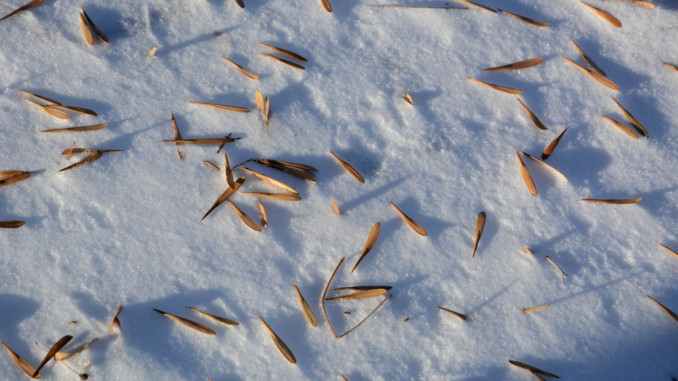

Bryan Fischer, Horticulturist, Gardens on Spring Creek
Many of us have tried and failed to grow annual flowers from seed. In my experience, the directions on seed packets advertised for such purposes just stink. “Sow indoors four to six weeks before last frost” is a paltry description for the enormous amount of fussing – watering, fertilizing, potting up, pinching, and hardening off – needed to produce a plant that has any chance of surviving transplant in our erratic Northern Colorado weather. Even when I’ve tried to “sow outdoors after the last frost”, I have found myself disappointed, with dozens of tiny seedlings cooked in a late spring heatwave during which I inevitably miss a watering day.
Rather than coughing up the dough for annual starts like a reasonable person might, I found a solution while scouring old seed catalogs years ago: sow your garden-to-be on top of decent winter snow. Not only do many seeds get trapped in the snow’s surface texture, but they also benefit from slow-release moisture with each spring snowstorm. They also get a bit of natural stratification (cold/wet treatment), which can aid germination rates in some plants. Perhaps best of all, these seeds sprout at a temperature that is appropriate for their biology, growing slowly and steadily over the course of spring. Seedlings resulting from snow-sowing typically bloom earlier in my garden than transplants and don’t require nearly as much fussing (hardening off, fertilizing, etc.).
Perhaps the biggest drawback of snow sowing is that seeds are likely to blow across the snow surface before the snow melts. I often don’t mind the naturalistic diaspora of bloom that results from another artist in the garden, but it’s not for everyone.
A variation of this tactic, utilized by one of my horticultural mentors, is to sow seeds on the soil surface in their intended location immediately before a winter storm arrives. This way, seeds are less likely to blow around if the weather gets blustery, and they receive the same benefits of snow sowing. I have found myself using this tactic more and more as the years go by, especially if I’m sowing seed that is a bit more valuable than something I find for three bucks at the garden center.
Regardless of which approach you try, you’ll find that these tactics work well, even if scurrying around the yard throwing out seed as snowflakes fly really fleshes out the “crazy gardener” look. I avoid sowing very tender annuals this way (zinnias, impatiens, geraniums), but try the technique liberally with any annual that I know has a bit of hardiness, including annual poppies, snapdragons, marigolds, Nigella (also called love-in-a-mist), and cosmos. If in doubt, give it a go with your favorite annual. I suspect you’ll be surprised by how many different types of flowers grow well from snow sowing.
Don’t hesitate to water your seedbeds beginning in early spring should we fail to get snow reliably. Just be sure to do so when temperatures are 50 degrees or higher. And, perhaps most crucially, be sure to take a moment to enjoy your work, even if it wasn’t much! There is something to be said for gardening smarter, not harder.
Support Northern Colorado Journalism
Show your support for North Forty News by helping us produce more content. It's a kind and simple gesture that will help us continue to bring more content to you.
BONUS - Donors get a link in their receipt to sign up for our once-per-week instant text messaging alert. Get your e-copy of North Forty News the moment it is released!
Click to Donate
